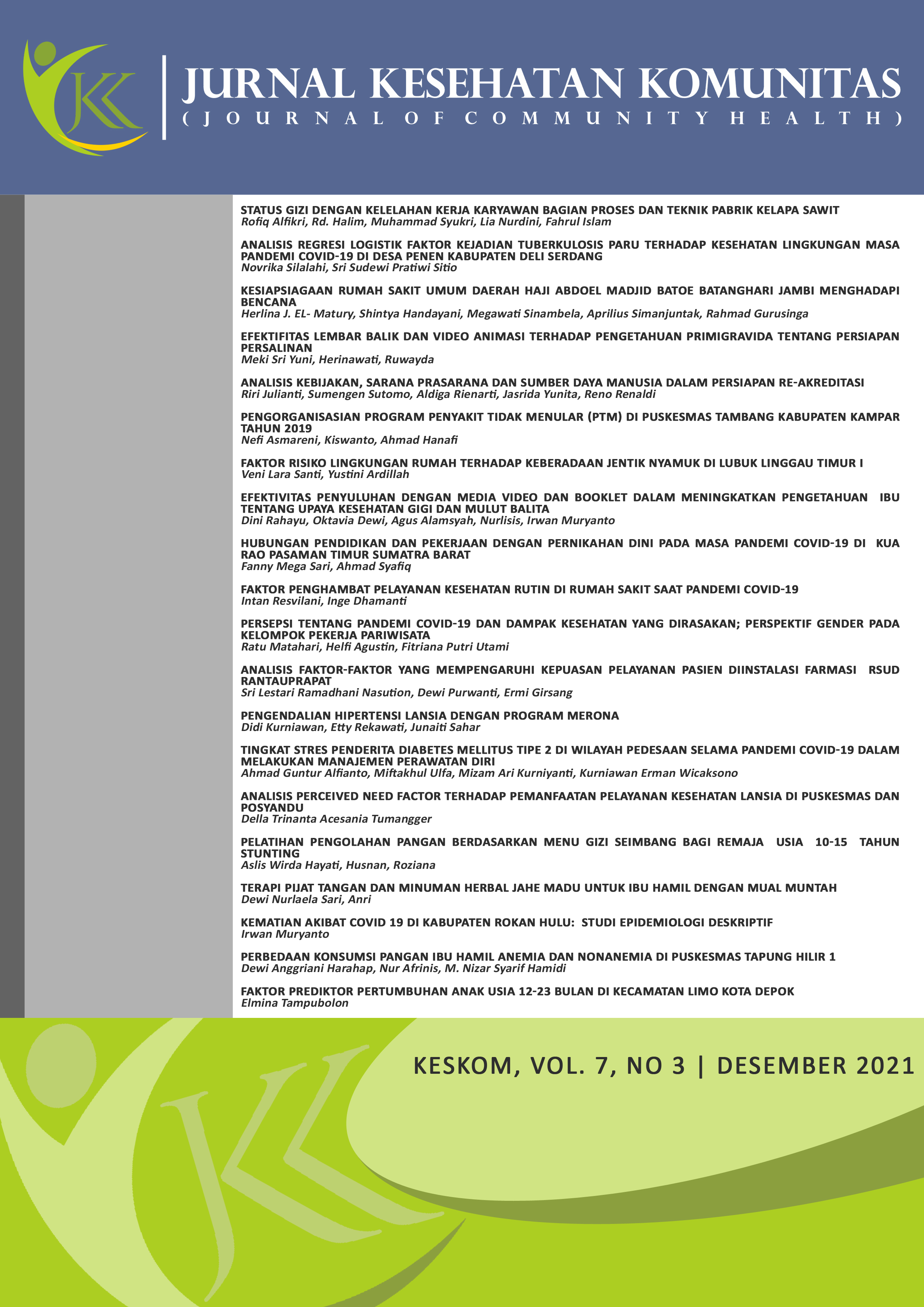Faktor Prediktor Pertumbuhan Anak Usia 12-23 Bulan di Kecamatan Limo Kota Depok
DOI:
https://doi.org/10.25311/keskom.Vol7.Iss3.1027Kata Kunci:
Prediktor; pertumbuhan; anak usia 12-23 bulanAbstrak
Pertumbuhan dan perkembangan masa bayi menentukan pertumbuhan dan perkembangan selanjutnya sampai dewasa. Beberapa hasil studi menunjukkan bahwa pengetahuan ibu adalah prediktor utama dari pertumbuhan anak, namun masih sedikit penelitian yang menguji variabel prediktor lainnya dari pertumbuhan anak. Penelitian ini bertujuan untuk menganalisis faktor prediktor dari pertumbuhan anak usia 12-23 bulan di Kecamatan Limo Kota Depok. Jenis penelitian adalah kuantitatif analitik. Desain kuantitatif yang digunakan adalah case control study. Sampel penelitian adalah seluruh ibu yang memiliki baduta berumur 12-23 bulan, Teknik pengambilan sampel dilakukan dengan cara purposive sampling. Analisis bivariat menggunakan uji chi-square, uji t-independen dan uji Mann-Whitney. Analisis multivariat menggunakan uji regresi logistik berganda. Hasil analisis menunjukkan bahwa pemberian susu tambahan dan frekuensi pemberian makan adalah faktor prediktor pertumbuhan anak usia 12-23 bulan. Saran pada Kementerian Kesehatan dan tenaga kesehatan di Puskesmas agar memperkuat program edukasi tentang pemberian makanan tambahan atau makanan pendamping Air Susu Ibu yang berkualitas dan jika perlu memberikan susu tambahan untuk mencegah kejadian stunting pada anak.
Unduhan
Referensi
Allen LHB. (2012). Vitamins In Breast Milk: Relative Importance of Maternal Status and Intake, and Effects on Infant Status and Function. Adv Nutr.3. 362–9.
Alles MS, Scholtens PAMJ, Bindels JG. (2004). Current trends in the composition of infant milk formulas, 51–63.
Bhandari N, Bahl R, Mazumdar S, Martines J, Black RE, Bhan MK. (2003).Infant feeding study group. Effect of community-based promotion of exclusive breastfeeding on diarrhoeal illness and growth: a cluster randomized controlled trial. Lancet. 361: 1418–23
Bravi F, Wiens F, Decarli A, Dal Pont A, Agostoni C, FerraronibM. (2016). Impact of Maternal Nutrition on Breast-milk Composition: A Systematic Review. Am J Clin Nutr. 104(3). 646–62
Dewey KG, Adu-afarwuah S. (2008). Review Article Systematic review of the efficacy and effectiveness of complementary feeding interventions in developing countries. Maternal and Child Nutrition. 4:24–85.
Erick M. (2018). Breast milk is conditionally perfect. Medical Hypotheses, 111. 82–89.
Ferdous F, Das J, Ahmed S, Malek MA, Das SK, Faruque ASG, Chisti MJ, Ma E, Wagatsuma Y. (2016). Nutritional status of children <5 years of age who have a working mother: an epidemiological perspective of diarrhoeal children in urban Bangladesh. Public Health Nutr. 19:2521–2524
Fleddermann M, Demmelmair H, Grote V, Nikolic T, Trisic B, Koletzko B. (2014). Infant formula composition affects energetic ef fi ciency for growth : The BeMIM study , a randomized controlled trial. Clinical Nutrition. 33(4), 588–595. https://doi.org/10.1016/j.clnu.2013.12.007
Georgiads A, Benny L, Duc LT, Galab S, Reddy P, Woldehanna T.(2017). Growth Recovery and Faltering Though Early Adolescence and Middle-income Countries: Determinans and Implications for Cognitive Development. Social Science and Medicine. Vol 179.81-90
Haider R, Saha KK. (2016). Breastfeeding and infant growth outcomes in the context of intensive peer counselling support in two communities in Bangladesh. International Breastfeeding Journal.1–11.
Kar BR, Rao SL, Chandramouli BA. (2008). Cognitive development in children with chronic protein energy malnutrition. Behavioral and Brain Functions. 4:31
Kavanagh-prochaska, K. (2006). Predictors of Bottle-Feeding Practices, Intake and Gowth of Formula-Fed Infants. University of California.
Kemenkes RI. (2017). Gizi Dalam Daur Kehidupan.Jakarta.
Kemenkes RI. (2018). Riset Kesehatan Dasar. Jakarta
More J, Jenkins C, King C. Shaw V. (2010). BDA Pediatric Group Position Statement: Weaning Infants onto Solid Foods. Brit. Diet. Assoc, 1.
Perkins JM, Kim R, Krishna A. et al. (2017). Understanding The Association Between Stunting and Child Development in Low-and Middle-Income Countries: Next Steps for Research and Intervention (Review). Social Science and Medicine.193.101-109
Pradhan M, Sahn DE, Younger SD. (2013). Decomposing world health inequality. J Health Econ. 22:271–93
Ryan AS, Zhou W, Arensberg MB. (2006). The Effect of Employment Status on Breastfeeding In The United States. Women’s Health Issues, 16, 243–251.
Scharf RJ, Rogawski ET, Murray-Kolb LE. et al.(2018). Early Childhood Growth and Cognitive Outcomes: Findings From The MAL-ED Study. Maternal and Child Nutrition
Shinn LM. (2017). Infant Feeding Practices In The First Six Months Of Life And Subsequent Growth Performance. ProQuest Que
Syed S, Rao R. (2015). Factors influencing nutritional status of school children in an urban slum of Hyderabad , India.Int J Contemp Pediatr 2:335–339
WHO. (2003). Implementing The Global Strategy For Infant and Young Child Feeding. Meeting Report, Geneva, 3–5 February 2003. Available from: http://www.who.int/nutrition/publications/infantfeeding
WHO. (2006). Child Growth Standart. WHO Press. Available from: http://www.WHO.int//nutrition.
WHO. (2016). Guidance on Ending The Inappropriate Promotion of Foods for Infants and Young Children. WHO Press. Available from: http://www.WHO.int//nutrition.
Wiegand M. (2008). Controversies in Nutrition: Breastfeeding and Human Lactation. Union Institute & University.
UNICEF. (2012). Ringkasan Kajian Gizi Ibu dan anak.The United Nations Children's Fund
Unduhan
Telah diserahkan
diterima
Diterbitkan
Cara Mengutip
Terbitan
Bagian
Lisensi
Hak Cipta (c) 2021 Jurnal Kesehatan Komunitas

Artikel ini berlisensiCreative Commons Attribution-NonCommercial-ShareAlike 4.0 International License.
Copyright @2017. This is an open-access article distributed under the terms of the Creative Commons Attribution-NonCommercial-ShareAlike 4.0 International License (http://creativecommons.org/licenses/by-nc-sa/4.0/) which permits unrestricted non-commercial used, distribution and reproduction in any medium












































